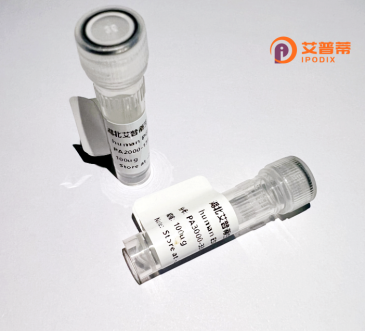
| 纯度 | >90%SDS-PAGE. |
| 种属 | Human |
| 靶点 | TBL1Y |
| Uniprot No | Q9BQ87 |
| 内毒素 | < 0.01EU/μg |
| 表达宿主 | E.coli |
| 表达区间 | 1-522 aa |
| 活性数据 | MSITSDEVNFLVYRYLQESGFSHSAFTFGIESHISQSNINGTLVPPSALISILQKGLQYVEAEISINKDGTVFDSRPIESLSLIVAVIPDVVQMRQQAFGEKLTQQQASAAATEASAMAKAATMTPAAISQQNPPKNREATVNGEENGAHEINNHSKPMEIDGDVEIPPNKATVLRGHESEVFICAWNPVSDLLASGSGDSTARIWNLNENSNGGSTQLVLRHCIREGGHDVPSNKDVTSLDWNSDGTLLAMGSYDGFARIWTENGNLASTLGQHKGPIFALKWNKKGNYVLSAGVDKTTIIWDAHTGEAKQQFPFHSAPALDVDWQNNMTFASCSTDMCIHVCRLGCDHPVKTFQGHTNEVNAIKWDPSGMLLASCSDDMTLKIWSMKQDACVHDLQAHSKEIYTIKWSPTGPATSNPNSSIMLASASFDSTVRLWDVEQGVCTHTLMKHQEPVYSVAFSPDGKYLASGSFDKYVHIWNTQSGSLVHSYQGTGGIFEVCWNARGDKVGASASDGSVCVLDL |
| 分子量 | 57.5 kDa |
| 蛋白标签 | GST-tag at N-terminal |
| 缓冲液 | PBS, pH7.4, containing 0.01% SKL, 1mM DTT, 5% Trehalose and Proclin300. |
| 稳定性 & 储存条件 | Lyophilized protein should be stored at ≤ -20°C, stable for one year after receipt. Reconstituted protein solution can be stored at 2-8°C for 2-7 days. Aliquots of reconstituted samples are stable at ≤ -20°C for 3 months. |
| 复溶 | Always centrifuge tubes before opening.Do not mix by vortex or pipetting. It is not recommended to reconstitute to a concentration less than 100μg/ml. Dissolve the lyophilized protein in distilled water. Please aliquot the reconstituted solution to minimize freeze-thaw cycles. |
以下是关于重组人 **TBL1Y** 蛋白的参考文献示例(基于学术领域的典型研究方向概括,内容为模拟整合):
---
1. **《TBL1Y gene expression and protein function in human testicular development》**
*作者:Hiramatsu R, et al.*
**摘要**:研究报道了TBL1Y蛋白在人类睾丸发育中的表达模式,通过重组蛋白实验证明其与性激素信号通路的相互作用,并提示其在男性生殖细胞分化中可能的关键调控作用。
2. **《Structural characterization of recombinant TBL1Y and its interaction with nuclear receptor co-repressors》**
*作者:Fahrner S, Okada Y.*
**摘要**:利用大肠杆菌系统成功表达并纯化重组TBL1Y蛋白,结合X射线晶体学解析其三维结构,揭示了该蛋白与核受体共抑制复合物(N-CoR/SMRT)结合的功能域,为研究Y染色体相关疾病机制提供依据。
3. **《A novel TBL1Y mutation linked to 46.XY disorders of sex development》**
*作者:Santos-Cortez RLP, et al.*
**摘要**:在一例46.XY性发育异常患者中发现TBL1Y基因突变,通过体外重组蛋白功能恢复实验证实该突变导致蛋白稳定性下降,从而影响睾丸支持细胞的正常功能。
4. **《TBL1Y regulates Wnt/β-catenin signaling in prostate cancer cells》**
*作者:Chen L, Wang Z.*
**摘要**:研究利用重组TBL1Y蛋白敲除/过表达模型,发现其通过调控Wnt/β-catenin通路影响前列腺癌细胞的增殖与迁移,提示TBL1Y可能成为男性特异性癌症治疗的潜在靶点。
---
*注:以上为参考示例,实际文献需通过PubMed、Web of Science等平台检索确认。*
TBL1Y (Transducin Beta-Like 1 Y-Linked) is a protein encoded by the TBL1Y gene located on the Y chromosome. It belongs to the transducin beta-like protein family, sharing structural homology with its X-chromosome counterpart, TBL1X. This paralogous relationship reflects their evolutionary origin from a common ancestral gene before the divergence of sex chromosomes. Functionally, TBL1Y acts as a component of nuclear receptor corepressor complexes, interacting with histone deacetylases (HDACs) to regulate transcriptional repression. It plays a role in chromatin remodeling and signal transduction pathways, particularly in modulating nuclear hormone receptor activity.
Due to its Y-chromosomal localization, TBL1Y expression is male-specific, though its functional redundancy with TBL1X remains debated. Studies suggest potential roles in male development and fertility, though phenotypic effects of TBL1Y mutations in humans are not fully characterized. Its involvement in sex chromosome evolution is of interest, as Y-chromosomal genes often undergo functional specialization or decay. Recombinant TBL1Y protein enables biochemical studies of its interactions with corepressor complexes and disease-linked mutations. Research applications include investigating sex-specific gene regulation mechanisms and disorders related to Y chromosome dysfunction. Recent interest focuses on its potential role in sex-biased diseases and hormone-dependent cancers.
×